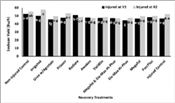|
"Recovery" Treatments For Dicamba-Injured Soybean – Results From A 2017 Experiment
DR. KEVIN BRADLEY, SHEA FARREL AND DR. MANDY BISH
COLUMBIA, MO.
Once dicamba injury has occurred to non-Xtend soybean, one of the common questions that will inevitably arise is, “can anything be done now to help the plants recover?” Last year we conducted one field research trial to address this question. In this research, we intentionally injured soybean with a 1/100X rate of dicamba at either the V3 or R2 stages of growth (black and gold bars, respectively, in Figure 1). Two weeks after the soybean were injured with dicamba at either growth stage, a variety of “recovery” treatments were applied to the dicamba-injured soybean. Our rationale for the two-week lapse in time between dicamba application and recovery treatment is that dicamba injury usually will take 7 to 10 days to show up, depending on the environment and rate. The recovery treatments we chose to evaluate included a variety of common foliar fertilizer products, a fungicide (Priaxor), urea with Agrotain, as well as one treatment that consisted of weekly irrigation. In short, we evaluated all of the possible solutions that we've heard promoted to help soybean recover from some kind of injury.
Yield results from the 2017 field experiment are shown in Figure 1. It is important to note that these are only results from one experiment in one season, but we are in the process of repeating this experiment in 2018. In Figure 1, there are two control treatments to which all recovery treatments should be compared; the non-injured control that was never injured by dicamba, and the dicamba-injured control that never received any recovery treatment. Results from the first year of the experiment indicate that when soybean were injured with dicamba at V3, no recovery tactic resulted in soybean yields that were higher than the dicamba-injured control (Figure 1). However, when soybean were injured with dicamba at R2, the weekly irrigation treatment resulted in yields higher than the injured control.
In fairness, we were surprised that the weekly irrigation treatment following the V3 drift event did not result in higher yields as well. But after looking through the rainfall data for this location in 2017, it was clear that timely rains were received throughout much of the early portions of the season, which likely contributed to the similarity in yield between the dicamba-injured control and all of the recovery treatments at the V3 timing. Overall these preliminary results indicate that the yield-promoting tactics evaluated here, except irrigation, are not candidates for enhancing soybean recovery following dicamba injury, and that the amount of rainfall or irrigation received after the dicamba injury event will have a significant role in determining how well the soybean will recover and yield. This research is being repeated in 2018 and it will be interesting to see if the results will be similar in a less-ideal growing season. ∆
DR. KEVIN BRADLEY, SHEA FARREL AND DR. MANDY BISH: University of Missouri

Figure 1 Influence of "recovery" treatments on dicamba-injured soybean yield in 2017.
|
|